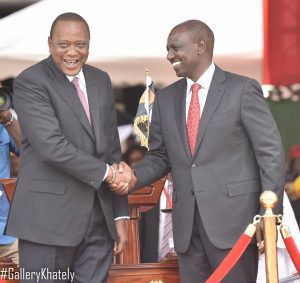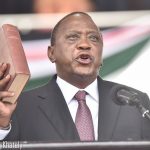The Guardian – Kenyan Graffiti Artists Step Up Battle Against ‘Vulture’ Politicians
By Clar Ni Chonghaile
It’s after 2am and Boniface Mwangi and his crew are ready for action. A portable generator roars into life, a projector balanced on a stack of cardboard boxes clicks on, and a sketch of bald-headed, big-beaked vultures in suits appears on the blank wall of a public toilet on Koinange Street in central Nairobi.
“Let’s start this thing,” says Mwangi. Five men in yellow fluorescent jackets, the kind city council workers wear, pick up spray cans and start tracing the sketch they prepared earlier.
The chemical smell of the paint is nose-ticklingly sharp but the message the young men are spraying is even sharper. The mural depicts members of Kenya’s parliament as vultures, with one carrying a briefcase labelled “stolen loot”. The text reads: “Describe your MP vulture” but the word “MP” has been crossed out with red paint. A list of options is given: thieves, irresponsible, selfish, pathetic, missing in action.
This is the team’s latest strike in a dead-of-night graffiti revolution they hope will encourage Kenyans to ditch politicians widely viewed as corrupt, ineffective and divisive at the next elections, likely either in December, or at the latest, in March next year.
“When guys are going to work, they see this,” Mwangi says, “and they remember, ‘my member of parliament is an idiot, a thug, he stole our land.'” A week ago, the crew spent the night stencilling “vote the vultures out of parliament” (in Swahili) on about 40 city junctions. They painted another mural in the business district on 28 February.
The artists – Uhuru B, Swift, Smokillah, Bankslave and another man who prefers not to be named – work fast, shaking, spraying, surveying. “It’s for the cause – revolution,” says Uhuru B, 26. “We have to wake people’s minds … and a picture is worth a thousand words …If it’s not us, it won’t be done. We’ve got the resources, we’ve got the skills. It’s the now.”
Bankslave, a stocky 28-year-old with dreadlocks, doesn’t say much but when he does, it’s to the point. “Activists, photojournalists and graffiti artists,” he said, describing the team. “And it takes balls.”
The latest mural on Koinange Street does not just target MPs. Beside a picture of a faceless man in a suit, it reads: “Corporate Kenya join us in speaking against tribal politics. Stop sleeping with the vultures.” A little lower, there is a message for the wired youth in East Africa’s tech hub: “Middle-class Kenyans get off Twitter and Facebook and do something positive offline.”
Mwangi, an award-winning photojournalist, is the instigator of these acts of artistic defiance. His aim is to bring about a ballot revolution by persuading Kenyans to kick out a political class long blamed for exploiting tribal differences to win power, and accused of a long record of corruption. His portfolio includes searing pictures of the chaos that followed the last elections in 2007, when more than 1,200 were killed in ethnic violence.
The father-of-three does not want to relive those days. He decries a culture of impunity among politicians, many of whom have been tarnished by corruption scandals that emerge regularly with no lasting consequences.
He once sold secondhand books on the street before turning to photography after someone gave him a biography of the Kenyan photojournalist Mo Amin, whose images of the Ethiopian famine in 1984 helped spur the global awakening that led to Live Aid.
Mwangi worked for local newspapers and won several awards, including CNN Africa photojournalist of the year in 2008 and 2010. He also founded Picha Mtaani, an organisation that focuses on reconciliation through photography and debate, and recently set up Pawa254 , a hub for young creative Kenyans that will shortly launch a Kickstarter or crowdfunding campaign.
He says the toilet mural will probably be the last in the centre of Nairobi – there aren’t enough blank walls – but his wider action plan includes screening documentaries urging reconciliation and hosting youth forums to try to engage people in politics. “We are trying to encourage men and women of integrity to vie for elective office because if they don’t, you’ll just find vultures on the ballot … If they don’t, we are doomed.” His biggest fear is that people won’t pay attention. “I’ll be so disappointed because I’m not sleeping, I’m here at night. If we do all this and we don’t get the ballot revolution, it will be an … anti-climax.”
President Mwai Kibaki, whose disputed victory in 2007 brought Kenya to the brink of disaster, cannot stand again. The prime minister, Raila Odinga, who lost to Kibaki and is from a different tribe, is expected to run. The other declared candidates include Uhuru Kenyatta, deputy prime minister and son of founding father Jomo Kenyatta, and William Ruto. These last two are among four men due to stand trial at the international criminal court for instigating the post-election violence.
Mwangi’s team painted their first political mural on the night of 28 February near the city market. It shows an MP as a vulture, sitting on a chair, his feet grinding into a women’s head. “MPs screwing Kenyans since 1963,” reads a footnote. The MP is saying: “I am a tribal leader … I steal their taxes, grab land but the idiots will still vote for me.”
“I just wish they could do it all over town and in every constituency,” said Kevin Wambua, a 23-year-old student. “It’s telling the truth about how we have been taken for a ride by leaders,” said businesswoman Esther Kiratu.
According to Mwangi, there are many animals used by Kenyans to describe their politicians, but his team chose the vulture “because the vulture feeds on the weak, the dead. It’s a scavenger.”
This time, the writing on the wall was destined to be short-lived. Just hours after the team finished painting the public toilets, city council workers turned up and covered the mural with blue paint. Mwangi remains defiant: “We will go back and paint it again. We won’t give up.”
This article first appeared on The Guardian




